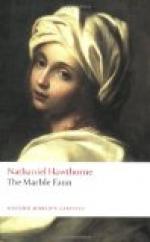The animal nature, indeed, is a most essential part of the Faun’s composition; for the characteristics of the brute creation meet and combine with those of humanity in this strange yet true and natural conception of antique poetry and art. Praxiteles has subtly diffused throughout his work that mute mystery, which so hopelessly perplexes us whenever we attempt to gain an intellectual or sympathetic knowledge of the lower orders of creation. The riddle is indicated, however, only by two definite signs: these are the two ears of the Faun, which are leaf shaped, terminating in little peaks, like those of some species of animals. Though not so seen in the marble, they are probably to be considered as clothed in fine, downy fur. In the coarser representations of this class of mythological creatures, there is another token of brute kindred,—a certain caudal appendage; which, if the Faun of Praxiteles must be supposed to possess it at all, is hidden by the lion’s skin that forms his garment. The pointed and furry ears, therefore, are the sole indications of his wild, forest nature.
Only a sculptor of the finest imagination, the most delicate taste, the sweetest feeling, and the rarest artistic skill—in a word, a sculptor and a poet too—could have first dreamed of a Faun in this guise, and then have succeeded in imprisoning the sportive and frisky thing in marble. Neither man nor animal, and yet no monster, but a being in whom both races meet on friendly ground. The idea grows coarse as we handle it, and hardens in our grasp. But, if the spectator broods long over the statue, he will be conscious of its spell; all the pleasantness of sylvan life, all the genial and happy characteristics of creatures that dwell in woods and fields, will seem to be mingled and kneaded into one substance, along with the kindred qualities in the human soul. Trees, grass, flowers, woodland streamlets, cattle, deer, and unsophisticated man. The essence of all these was compressed long ago, and still exists, within that discolored marble surface of the Faun of Praxiteles.
And, after all, the idea may have been no dream, but rather a poet’s reminiscence of a period when man’s affinity with nature was more strict, and his fellowship with every living thing more intimate and dear.
CHAPTER II
THE FAUN
“Donatello,” playfully cried Miriam, “do not leave us in this perplexity! Shake aside those brown curls, my friend, and let us see whether this marvellous resemblance extends to the very tips of the ears. If so, we shall like you all the better!”
“No, no, dearest signorina,” answered Donatello, laughing, but with a certain earnestness. “I entreat you to take the tips of my ears for granted.” As he spoke, the young Italian made a skip and jump, light enough for a veritable faun; so as to place himself quite beyond the reach of the fair hand that was outstretched, as if to settle the matter by actual examination. “I shall be like a wolf of the Apennines,” he continued, taking his stand on the other side of the Dying Gladiator, “if you touch my ears ever so softly. None of my race could endure it. It has always been a tender point with my forefathers and me.”




